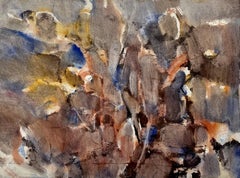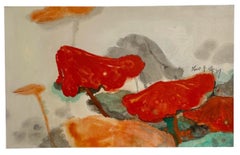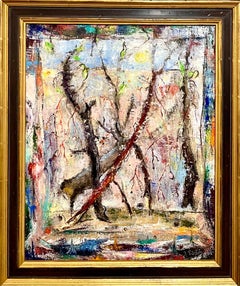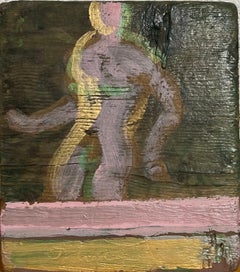Want more images or videos?
Request additional images or videos from the seller
1 of 9
Elizabeth DaCosta AhernElizabeth Ahern Abstract Expressionist Color Field Oil Painting1978
1978
Price:$2,500
About the Item
- Creator:Elizabeth DaCosta Ahern (American)
- Creation Year:1978
- Dimensions:Height: 20 in (50.8 cm)Width: 25 in (63.5 cm)
- Medium:
- Movement & Style:
- Period:
- Condition:
- Gallery Location:Surfside, FL
- Reference Number:1stDibs: LU3827940842
About the Seller
4.9
Platinum Seller
Premium sellers with a 4.7+ rating and 24-hour response times
Established in 1995
1stDibs seller since 2014
1,846 sales on 1stDibs
Authenticity Guarantee
In the unlikely event there’s an issue with an item’s authenticity, contact us within 1 year for a full refund. DetailsMoney-Back Guarantee
If your item is not as described, is damaged in transit, or does not arrive, contact us within 7 days for a full refund. Details24-Hour Cancellation
You have a 24-hour grace period in which to reconsider your purchase, with no questions asked.Vetted Professional Sellers
Our world-class sellers must adhere to strict standards for service and quality, maintaining the integrity of our listings.Price-Match Guarantee
If you find that a seller listed the same item for a lower price elsewhere, we’ll match it.Trusted Global Delivery
Our best-in-class carrier network provides specialized shipping options worldwide, including custom delivery.You May Also Like
Water for Wagon
By Rocky Hawkins
Located in Bozeman, MT
Rocky Hawkins was born in 1950 in Seattle, Washington and grew up in small towns near the Cascades Mountains. His interest in the mystery and spiritual element of the Indian culture ...
Category
2010s Abstract Expressionist Landscape Paintings
Materials
Oil, Archival Paper
Mid Century Bay Area Abstract Expressionist -- Oak Woodlands of Golden Gate Park
By Honora Berg
Located in Soquel, CA
Bay Area Abstract Expressionist -- Oak Woodlands of San Francisco Golden Gate Park
This mid-century painting by Honora Berg (American, 1897-1985) depicts coastal live oaks of Golden...
Category
1950s Abstract Expressionist Abstract Paintings
Materials
Archival Paper, Oil Crayon, Watercolor
$890
H 19.75 in W 14 in D 0.13 in
Vivid Looping Lines on Turquoise, Red, Green & Ocre Brushstrokes Diptych, Urban
By Natalia Roman
Located in Barcelona, ES
"Vivid Looping Lines on Turquoise" is an abstract painting diptych by Spanish artist Natalia Roman. It is a beautiful series of rhythmic brushstrokes combined with subtle tones and u...
Category
2010s Abstract Expressionist Abstract Paintings
Materials
Oil, Acrylic, Paper
Untitled
Located in Pampilhosa da Serra, PT
Maria Luísa Capela’s - untitled- (56 × 76 cm, oil on paper) is a vivid exploration of botanical form through expressive colour and intuitive mark-making. The work features deep burgu...
Category
21st Century and Contemporary Abstract Expressionist Abstract Paintings
Materials
Paper, Oil
Jon Rowland, Untitled: Interior 2, Original Abstract Painting, Bright Art
By Jon Rowland
Located in Deddington, GB
Jon Rowland
Untitled : Interior 2
Original Abstract Painting
Acrylic and Oil Paint on Paper
Board Size: H 57cm x W 76 cm
Sold Unframed
(Please note that in situ images are purely an ...
Category
21st Century and Contemporary Abstract Expressionist Abstract Paintings
Materials
Paper, Oil
$1,964
Free Shipping
H 22.45 in W 29.93 in D 0.04 in
Contemporary abstract impressionist seascape seaside acrylic painting on paper
Located in VÉNISSIEUX, FR
This artwork "When the blue sky meets the blue sea" is a captivating example of abstract expressionism, where vibrant color and dynamic brushwork coalesce to evoke an emotive landsc...
Category
2010s Abstract Expressionist Landscape Paintings
Materials
Paper, Oil
Mougenot NatalyaContemporary abstract impressionist seascape seaside acrylic painting on paper, 2024
$275
H 8.27 in W 5.91 in D 0.04 in
Contemporary small abstract impressionist seascape seaside oil painting on paper
Located in VÉNISSIEUX, FR
This artwork named " Exploring the sea cliff" is a vibrant and expressive landscape painting that captures the raw essence of nature through dynamic brushstrokes and bold colors.
D...
Category
2010s Abstract Expressionist Landscape Paintings
Materials
Paper, Oil
$275
Free Shipping
H 8.27 in W 5.91 in D 0.04 in
Impressionist seascape nature painting paper "Dreaming of the south of France"
Located in VÉNISSIEUX, FR
This contemporary seaside landscape, infused with the spirit of Impressionism and a hint of Expressionism, is part of my ongoing series celebrating the essence of summer. Titled "Dre...
Category
2010s Abstract Expressionist Landscape Paintings
Materials
Paper, Oil
$335
Free Shipping
H 16.54 in W 11.7 in D 0.04 in
Untitled Landscape (1967)
By Adine Stix
Located in Summit, NJ
Gorgeous oil on paper by abstract expressionist artist Adine Stix. Beautiful hades of pink, with purple, blue, yellow and a touch of brown create a gorgeous abstract landscape. Sign...
Category
1960s Abstract Expressionist Abstract Paintings
Materials
Paper, Oil, Watercolor
Abstract Expressionist - Original 60's oil/spray paint on paper S. African art
By Denis Bowen
Located in Hagley, England
An original oil and spray paint on paper by Denis Bowen who played an important role in the Post War British art movement. This simple yet stunning work dates to 1962.
Signed and dated verso.
Provenance. Northern collection.
Condition. Oil and spray paint on paper. Image size 26 inches by 18 inches and in fine gallery condition.
Housed in a simple black gallery frame in excellent condition, 28 inches by 20 inches.
Denis Bowen (1921-2006) was a South African artist, gallery director and promoter of abstract and avant-garde art in Britain. He was founder of the New Vision Group and the New Vision Centre Gallery, both of which played an important role in the post-World War II British art scene. Denis Bowen was born on 5 April 1921 in Kimberley, South Africa. His father was Welsh and his mother English. After being orphaned at a young age, Bowen moved to England where he was raised by his aunt in Huddersfield. He enrolled at the Huddersfield School of Art in 1936. After serving in the Navy in World War II, Bowen resumed his art studies at the Royal College of Art in London in 1946. Between 1940 and 1986 Bowen taught art at numerous institutions including: the Kingston Institute of Art, Hammersmith School of Art, Birmingham School of Art, the Central School of Art and Design, the Royal College of Art and the University of British Columbia in Vancouver. In 1951 Bowen founded the New Vision Group, which initially emerged from meetings and displays that he organised with his students in 1951. In 1955, Bowen worked alongside Frank Avray Wilson and Halima Nalecz...
Category
1960s Abstract Expressionist Abstract Paintings
Materials
Paper, Oil, Spray Paint
$1,530 Sale Price
20% Off
H 20 in W 28 in D 2 in
More From This Seller
View AllLarge Modernist Abstract Expressionist Watercolor Painting Bauhaus Weimar Artist
By Pawel Kontny
Located in Surfside, FL
Abstract watercolor composition bearing the influence of the earlier color-block compositions of Paul Klee.
Pawel August Kontny, (Polish-German-American artist) He was born in Laurahuette, Poland, in 1923, the son of a wealthy pastry shop owner. In 1939 he began studying architecture in Breslau where he was introduced to the European masters and to the work of some of the German Expressionists, soon afterward banned as "degenerate artists" and removed from museums throughout Germany by the Nazi regime. His studies were interrupted by World War II. Drafted into the German army, traveling in many countries as a soldier, he sketched various landscapes but in 1945, he was captured and held as a prisoner of war in Italy. After the war, he studied at the Union of Nuremberg Architects to help design buildings to replace ones destroyed in the war. He recorded his impressions of the local population and the landscapes through his watercolors and drawings. Pawel Kontny thereafter moved to Nuremberg, Germany, becoming a member of the Union of Nuremberg Architects and helping to rebuild the city's historic center. He soon decided to concentrate on his professional art career. He married Irmgard Laurer, a dancer with the Nuremberg Opera. Pavel Kontny 's career as an artist was launched with his participation in an all German exhibition, held at the Dusseldorf Museum in 1952. He held one-man shows in Germany, Switzerland and the United States. During his trip to the United States in 1960, Kontny became instantly enamored with Colorado, and decided to relocate to Cherry Hills with his wife and two children. He quickly established himself in the local art community, being affiliated for a time with Denver Art Galleries and Saks Galleries. His subject matter became the Southwest. During this time he received the Prestigious Gold Medal of the Art Academy of Rome. His extensive travel provided material for the paintings he did using his hallmark marble dust technique. he also worked equally in pastel, watercolor, charcoal and pencil-and-ink. in a style which merged abstraction and realist styles, influenced by Abstract Expressionist painting and South Western American landscapes. In the early 1960s he was one of only a few European-born professional artists in the state, a select group that included Herbert Bayer (1900-1985), a member of the prewar Bauhaus in Weimar and Dessau, Germany, and Roland Detre...
Category
Mid-20th Century Abstract Expressionist Landscape Paintings
Materials
Watercolor, Archival Paper
Large Abstract Expressionist Lotus Flower Taiwanese Chinese Painting Kuo Yu-Lun
Located in Surfside, FL
KUO YU-LUN (GUO YULUN, CHINA, 1930-2001)
Important Chinese Artist Modernist Yu-Lun Kuo
Oil Painting
Hand signed Kuo, dated 1967,
titled, "Lotus in Vermillion",
Provenance: Wah-Cheung Art Gallery ,
Dimensions: 29 x 46.5
In 1956, Kuo Tung-Jung (Guo Dongrong; b. 1927), Liu Kuo-sung (Liu Guosong; b. 1932), Kuo Yu-Lun (Guo Yulun; 1900–68) and Li Fang...
Category
1960s Abstract Expressionist Abstract Paintings
Materials
Canvas, Oil
Nell Sinton Abstract Expressionist Landscape San Francisco California Modernist
Located in Surfside, FL
Eleanor Nell Sinton
Roots and Stems 1950,
Oil on canvas,
Signed lower right N. Sinton,
Provenance: Braunstein Quay Gallery (bears label verso)
Framed: 24.5 X 20.5 sight 21 X 17 i...
Category
1950s Abstract Expressionist Abstract Paintings
Materials
Canvas, Oil
Mod Abstract Expressionist Modernist Oil Painting Edward Avedisian Color Figure
By Edward Avedisian
Located in Surfside, FL
Edward Avedisian ( 1936-2007 )
8 X 9
Oil paint on wood plank panel with gold and purple figure
This is not signed on front. It bears his name verso.
Provenance: Hudson, N.Y. estate of noted Art Collector Albert Burnette Roberts (1932-2021)
Edward Avedisian (June 15, 1936, Lowell, Massachusetts – August 17, 2007, Philmont, New York) was an American abstract painter who came into prominence during the 1960s. His work was initially associated with Color field painting and in the late 1960s with Lyrical Abstraction and Abstract Expressionism.
He studied art at the School of the Museum of Fine Arts, Boston. By the late 1950s he moved to New York City. Between 1958 and 1963 Avedisian had six solo shows in New York. In 1958 he initially showed at the Hansa Gallery, then he had three shows at the Tibor de Nagy Gallery and in 1962 and 1963 at the Robert Elkon Gallery. He continued to show at the Robert Elkon Gallery almost every year until 1975.
During the 1960s his work was broadly visible in the contemporary art world. He joined the dynamic art scene in Greenwich Village, frequenting the Cedar Tavern on Tenth Street, associating with the critic Clement Greenberg, and joining a new generation of abstract artists, such as Darby Bannard, Kenneth Noland, Jules Olitski, and Larry Poons.
Avedisian was among the leading figures to emerge in the New York art world during the 1960s. An artist who mixed the hot colors of Pop Art with the cool, more analytical qualities of Color Field painting, he was instrumental in the exploration of new abstract methods to examine the primacy of optical experience.
One of his paintings was appeared on the cover of Artforum, in 1969, his work was included in the 1965 Op Art The Responsive Eye exhibition at the Museum of Modern Art and in four annuals at the Whitney Museum of American Art. His paintings were widely sought after by collectors and acquired by major museums in New York and elsewhere. He has been exhibited in prominent galleries, such as the Anita Shapolsky Gallery and the Berry Campbell...
Category
1960s Abstract Expressionist Landscape Paintings
Materials
Oil, Wood Panel
Abstract Expressionist Landscape Israeli Modernist Oil Painting, Moody Blue
By Shimon Avny
Located in Surfside, FL
Shimon Avni
Shimon Avny, painter, born 1932, Paris
Shimon Avny (Stein) was born in Paris, France. He grew up in the Belville neighborhood. In 1942, when the Nazis occupied France, he was separated from his family. His mother and brothers were killed in the Holocaust. After the war, he was transferred from his hiding place to the town of Andlis. He immigrated to Israel with Youth Aliyah in 1948. In 1956, he joined Kibbutz Ra'im. In 1957, he studied painting with Joseph Zaritsky, Avigdor Stematzky and Haim Kiewe. He also studied with Yehezekel Streichman at the Avni Institute. At the end of the 1950s, he went to Paris to continue his studies. In the 1980s, he joined the Radius artists cooperative.
Avny's early work was influenced by the abstractionism of the New Horizons group. In 1963, he took part in the group's exhibition at Ein Harod. His work is characterized by bold colors, expressive brushstrokes and flat planes. He is a figurative painter, but some of his work incorporates symbolic imagery.
Education
1957 Painting with Joseph Zaritsky, Avigdor Stematsky and Haim Kiewe
Avni Institute, Tel Aviv, with Yehezkel Streichman
Grande Chaumiere Academy, Paris, 1958
Ecole des Beaux Arts, Paris, 1961
Fine Arts Academy, Rome
Photography and television, Paris, 1965-67
Teaching
Lectured abroad for the Ministry of Education and Culture, 1969-71
Bezalel Academy, Jerusalem, painting, 1974-78
College of Visual Arts, Beersheba, 1975-81
Headmaster of the Art Institute, Rehovot, 1975-85
1981-85 and 1988-92 Art Teachers College, Ramat Hasharon
Since1992 Avni Institute, Tel Aviv, Teacher and coordinator of the Arts Department
Awards And Prizes
1975 The America-Israel Cultural Fund Scholarship
1985 Scholarship, The Cité Internationale des Arts, Paris, France
1993 The America-Israel Cultural Foundation, Sharett Fund Scholarship for a Young Artist.
A member of the Aclim Group, which was organized in 1974. The group was established in the wake of the Yom Kippur War to point to the necessity of raising the public's consciousness of its Israeli identity in all cultural spheres. Participants in the group's exhibitions until 1983 were: Eliyahu Gat, Rahel Shavit, Ori Reisman, Avram Rafael, Michael Gross, Hannah Levy...
Category
Mid-20th Century Abstract Expressionist Abstract Paintings
Materials
Jute, Oil
Mod Abstract Expressionist Modernist Oil Painting Edward Avedisian Color Circles
By Edward Avedisian
Located in Surfside, FL
Edward Avedisian ( 1936-2007 )
17.5 X 8.75
Oil paint on wood panel
This is not signed on front. It bears his name verso.
Provenance: Hudson, N.Y. estate of noted Art Collector Alber...
Category
1960s Abstract Expressionist Landscape Paintings
Materials
Oil, Wood Panel
Still Thinking About These?
All Recently ViewedMore Ways To Browse
Black And White Erotic Photography
Capri Italy
French World War I Posters
Modern Horse Art
Vanity Fair Magazine
Japan Art Landscape
Large Vintage Photo
1930s Print
Contemporary Figurative Ceramic Sculpture
French Lithograph Posters
Leo Castelli
Waldorf Astoria
Time Further
Antique Linen Paper
Old Woman
Exhibition Photos
Vintage Bernard Prints
Pablo Picasso Femme



